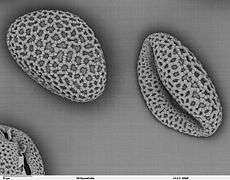Lilium auratum
| Lilium auratum | |
|---|---|
 | |
| Scientific classification | |
| Kingdom: | Plantae |
| (unranked): | Angiosperms |
| (unranked): | Monocots |
| Order: | Liliales |
| Family: | Liliaceae |
| Genus: | Lilium |
| Species: | L. auratum |
| Binomial name | |
| Lilium auratum Lindl. | |
Lilium auratum (山百合 yamayuri; literally "mountain lily") is one of the true lilies. It is native to Japan and is sometimes called the golden rayed lily of Japan or the goldband lily.
Description
The flower colour is typically white with gold radial markings and orange spots, but variations in flower colour and markings are known. For example the variety platyphyllum which bears a gold stripe along the tepals but lacks spots.[1] The strongly scented flowers are the largest of any lily species and the largest plants, which can reach 2.5 metres (8 ft), can carry up to twenty of these.
It has been used widely in breeding and many of the more spectacular modern cultivars are derived in part from this species.

Cultivation
This lily does well in plain or acidic soil; rich or fertilised soil will kill the plant. Bulbs should be planted in a hole three times their size in both depth and width in a well drained area. The best position for this plant is one where its top will receive sunlight while its base remains shaded.
This lily can be cultivated by seed, but for faster reproduction scaling is recommended. Its life span (around 3 or 4 years) is significantly less than that of its descendants, so reproducing this plant is important for gardeners.
Chemistry
L. auratum contains phenolic glycerides such as 1,2-O-diferuloylglycerol, 1-O-feruloyl-2-O-p-coumaroylglycerol, 1-O-p-coumaroyl-2-O-feruloylglycerol, 1-O-feruloylglycerol, 1,3-O-diferuloylglycerol, 1-O-feruloyl-3-O-p-coumaroylglycerol and 1-O-p-coumaroylglycerol.[2]
Toxicity
Cats
Cats are extremely sensitive to lilly toxicity and ingenstion is often fatal;[3][4][5] households and gardens which are visited by cats are strongly advised against keeping this plant or placing dried flowers where a cat may brush against them and become dusted with pollen which they then consume while cleaning.[6] Suspected cases require urgent veterinary attention.[7] Rapid treatment with activated charcoal and/or induced vomiting can reduce the amount of toxin absorbed (this is time-sensitive so in some cases vets may advise doing it at home), and large amounts of fluid by IV can reduce damage to kidneys to increase the chances of survival.[7]
References
- ↑ The RHS Encyclopedia of Garden Plants, Christopher Brickell, Dorling Kindersley, London, 1996, p613. ISBN 0-7513-0436-0
- ↑ Phenolic glycerides from Lilium auratum. Hiroko Shimomura, Yutaka Sashida and Yoshihiro Mimaki, Phytochemistry, 1987, Volume 26, Issue 3, Pages 844–845, doi:10.1016/S0031-9422(00)84801-3
- ↑ Frequently Asked Questions No Lillies For Cats.
- ↑ Lily toxicity in the cat. Kevin T. Fitzgerald, PhD, DVM, DABVP.
- ↑ Pets and toxic plants UC Davis Vetenry Medicine.
- ↑ The Valentine bouquet that killed my cats: Mother's Day warning on lethal lilies Daily Mail.
- 1 2 Lily Poisoning in Cats. Pet MD.
